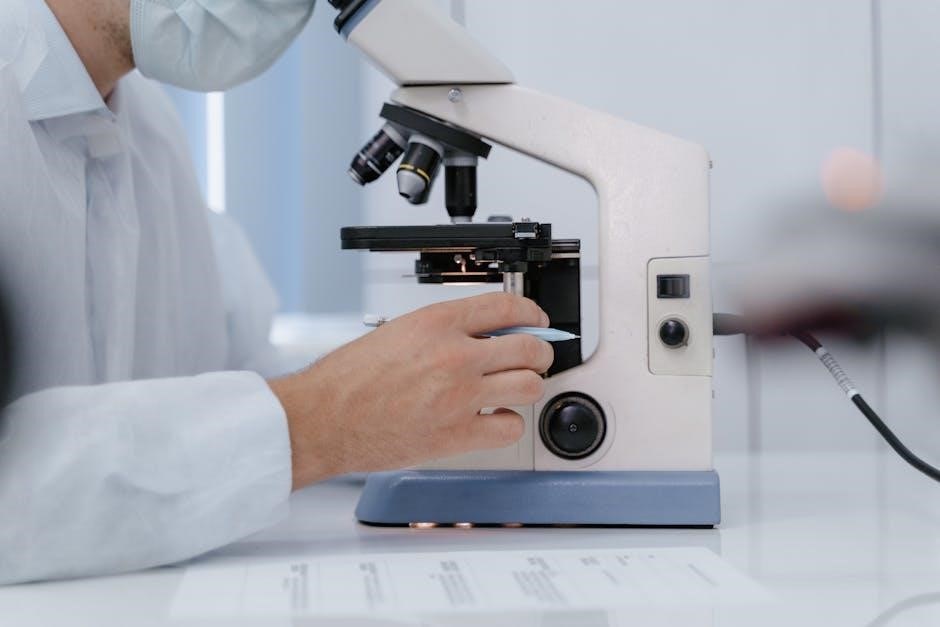Welcome to Unit 1 of Biology, where we explore the fundamentals of life sciences. This unit introduces key biological concepts, including cell theory, biological molecules, enzymes, and transport mechanisms, providing a solid foundation for understanding life’s processes.
1.1 Overview of Unit 1 Objectives
Unit 1 of Biology is designed to provide a comprehensive introduction to the field, focusing on foundational concepts and skills essential for understanding biological processes. Key objectives include developing an appreciation for the scientific method, exploring cell structure and function, and introducing biological molecules and enzymes. Students will gain proficiency in microscopy techniques and learn to analyze experimental data. The unit also emphasizes critical thinking and the application of biological principles to real-world scenarios. By the end of this unit, learners will have a solid understanding of the building blocks of life and the tools to investigate biological systems effectively;
1.2 Key Concepts and Topics Covered
Unit 1 delves into essential biological principles, starting with an overview of the scientific method and the structure of biological molecules. The unit covers cell theory, including the three tenets and the differences between prokaryotic and eukaryotic cells. Additionally, it explores biological molecules such as carbohydrates, lipids, proteins, and nucleic acids, their monomers, and functions. Enzymes and their roles in biochemical reactions are also examined, along with factors influencing enzyme activity. The unit introduces transport mechanisms in cells, including osmosis, diffusion, and active transport. Finally, it incorporates microscopy techniques and experimental design, equipping students with practical scientific skills.

Cell Theory and Cell Structure
This section explores cell theory, including its three foundational principles, and examines cell structure, emphasizing the differences between prokaryotic and eukaryotic cells and their components.
2.1 The Three Tenets of Cell Theory
Cell theory consists of three core principles: all life is composed of cells, new cells arise from pre-existing cells, and cells are the basic structural and functional units of living organisms. These tenets, developed by Schleiden, Schwann, and Virchow, provide the foundation for modern cellular biology, emphasizing the universality of cells in life processes and their role in reproduction and function. Understanding these principles is essential for grasping biological concepts, as they form the cornerstone of cell structure and function studies.
2.2 Prokaryotic vs. Eukaryotic Cells
Prokaryotic cells, such as bacteria, lack a nucleus and membrane-bound organelles, while eukaryotic cells, found in plants, animals, and fungi, have a nucleus and complex organelles. Prokaryotes are smaller and simpler, with fewer structural components, whereas eukaryotes are larger and more complex, enabling specialized functions. The presence of organelles like mitochondria in eukaryotes allows for advanced energy production, distinguishing them from prokaryotes. This fundamental difference underpins the diversity of life, shaping the structure and function of organisms across the biological spectrum.

Biological Molecules
Biological molecules, including carbohydrates, lipids, proteins, and nucleic acids, are essential for life. They perform diverse functions, from energy storage to genetic information storage, sustaining life’s processes.
3.1 Macromolecules: Carbohydrates, Lipids, Proteins, and Nucleic Acids
Macromolecules are large, complex molecules essential for life. Carbohydrates, like glucose, serve as energy sources. Lipids, including fats and oils, store energy and form membranes. Proteins, built from amino acids, perform diverse functions such as catalysis and structural support. Nucleic acids, like DNA and RNA, store genetic information. These molecules are vital for cellular function, growth, and reproduction, forming the foundation of biological processes.
3.2 Monomers, Polymers, and Their Functions
Monomers are the building blocks of macromolecules, combining to form polymers through chemical bonds. For carbohydrates, monosaccharides like glucose link to form disaccharides and polysaccharides. Lipids are built from fatty acids and glycerol, creating fats and oils. Proteins are polymers of amino acids, essential for structural and functional roles. Nucleic acids, such as DNA and RNA, are polymers of nucleotides. Each monomer-polymer relationship is vital for specific biological functions, from energy storage to genetic coding, illustrating the complexity and diversity of life’s molecular architecture.
Enzymes and Biochemical Reactions
Enzymes act as biological catalysts, accelerating biochemical reactions by lowering activation energy. They are essential for life, enabling processes like metabolism, digestion, and DNA replication to occur efficiently.
4.1 Role of Enzymes in Biological Processes
Enzymes play a crucial role in biological processes by catalyzing essential biochemical reactions. They enable cells to metabolize nutrients, replicate DNA, repair tissues, and maintain homeostasis. Without enzymes, these processes would be too slow to sustain life. Enzymes act as highly specific catalysts, binding to substrates and lowering activation energy. This specificity ensures that reactions occur accurately and efficiently. Additionally, enzymes regulate metabolic pathways, allowing cells to respond to environmental changes. Their role is vital in digestion, respiration, and synthesizing molecules like proteins and nucleic acids, making them indispensable for cellular function and overall organism survival.
4.2 Factors Affecting Enzyme Activity
Enzyme activity is influenced by several factors, including temperature, pH, substrate concentration, and the presence of inhibitors. Optimal temperature and pH are crucial for maintaining enzyme structure and function. Excessive heat can denature enzymes, while extreme pH levels can disrupt their active sites. Substrate concentration affects reaction rates, but enzymes can reach maximum velocity when saturated. Inhibitors, such as competitive or non-competitive molecules, can reduce or block enzyme activity. Understanding these factors is essential for regulating biochemical processes, as they allow cells to control reaction rates and adapt to environmental changes, ensuring efficient metabolic pathways and cellular homeostasis.

Transport in Cells
Transport in cells involves the movement of molecules across membranes, essential for cellular function. Processes include diffusion, osmosis, and active transport, each vital for maintaining cellular homeostasis and proper function.
5.1 Osmosis and Diffusion
Osmosis and diffusion are essential passive transport mechanisms in cells. Osmosis refers to the movement of water molecules across a semipermeable membrane from an area of low solute concentration to high. Diffusion involves the random movement of particles from high to low concentration, aiming to reach equilibrium. Both processes are vital for maintaining cellular balance and proper function. For example, osmosis regulates water uptake in plant roots, while diffusion aids in oxygen intake and carbon dioxide expulsion in cells. Understanding these concepts is fundamental for grasping how cells interact with their environment and sustain life.
5.2 Active Transport and Its Importance
Active transport is the energy-requiring process by which cells move molecules against their concentration gradient. Unlike passive transport, it demands ATP and carrier proteins to pump substances into or out of the cell. This mechanism is vital for maintaining cellular homeostasis, absorbing nutrients, and regulating ion concentrations. For example, nerve cells use active transport to transmit signals, while intestinal cells absorb glucose through this process. It ensures essential molecules are available for cellular functions, even when their external concentration is low. Understanding active transport highlights its critical role in sustaining life and cellular operations. It is a cornerstone of cellular physiology.

Scientific Skills and Experiments
This section focuses on developing practical skills in microscopy, experimental design, and data analysis. Students learn to study cells, design experiments, and interpret results accurately.
6.1 Microscopy and Cell Study Techniques
Microscopy is a cornerstone of biological studies, enabling detailed observations of cells and their structures. Light microscopes are widely used for basic cell studies, while electron microscopes provide higher resolution for more detailed analysis. Students learn techniques such as staining, sectioning, and slide preparation to enhance visibility. These skills are essential for understanding cellular morphology and functionality. Practical exercises often involve observing live and preserved cells, identifying organelles, and documenting findings. Mastering microscopy fosters a deeper appreciation of cellular biology and prepares students for advanced laboratory work in subsequent units.
6.2 Designing and Analyzing Experiments
Designing and analyzing experiments is crucial for scientific inquiry in biology. Students learn to formulate hypotheses, identify variables, and establish controlled conditions. Data collection involves precise measurements and observations, followed by statistical analysis to draw meaningful conclusions. Key techniques include comparing experimental and control groups, ensuring reliability through repetition, and validating results. Analyzing data helps determine whether findings support the hypothesis. Graphs, charts, and tables are essential tools for presenting results. Understanding experimental design and analysis builds critical thinking skills, enabling students to evaluate evidence and refine their investigative methods. This skillset is foundational for advanced biological research and experimentation.
This section recaps key concepts from Unit 1, ensuring a strong grasp of foundational biology topics. It highlights essential takeaways and study strategies for long-term retention.
By summarizing main ideas and reinforcing learning techniques, students prepare for future units and build a solid understanding of biological principles and methodologies.
7.1 Key Takeaways from Unit 1
Cell Theory: All life is composed of cells, cells are the basic structural and functional units, and new cells arise from existing ones.
Cell Structure: Prokaryotic cells lack a nucleus, while eukaryotic cells have membrane-bound organelles like the nucleus, mitochondria, and ribosomes.
Biological Molecules: Carbohydrates, lipids, proteins, and nucleic acids are essential macromolecules, each with unique functions.
Enzymes: Biological catalysts that speed up reactions, influenced by factors like temperature, pH, and substrate concentration.
Transport Mechanisms: Passive transport (osmosis, diffusion) and active transport are crucial for cellular function.
Scientific Skills: Microscopy, experiment design, and data analysis are fundamental for studying biology.
7.2 Strategies for Effective Studying
To master Biology Unit 1, adopt active learning techniques. Start by outlining key concepts and organizing notes into clear categories. Engage with diagrams and visuals to reinforce complex ideas. Practice past exam questions to familiarize yourself with question formats. Use flashcards to memorize vocabulary and processes. Regularly review summaries and concept maps to retain information. Join study groups to discuss challenging topics and clarify doubts. Set specific study goals and allocate time for each section. Lastly, seek help from instructors or online resources when needed. Consistent effort and these strategies will enhance your understanding and performance.